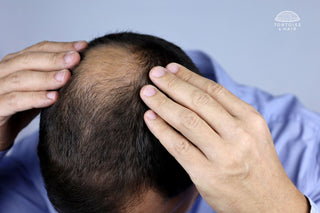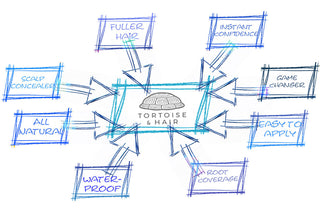Central Centrifugal Cicatricial Alopecia (CCCA) is a type of scarring alopecia that primarily affects Black women, although it can occur in men and individuals of other ethnicities. The condition begins with hair thinning at the crown of the scalp and gradually spreads outward in a circular pattern. Over time, inflammation destroys hair follicles, leading to permanent hair loss and scarring.
The exact cause of CCCA remains unclear, but it is believed to involve a combination of genetic predisposition, hairstyling practices, and possible hormonal or inflammatory triggers. Studies estimate that up to 15% of Black women may experience CCCA, making it one of the most common types of alopecia in this demographic.
What Are the Symptoms?
The most noticeable symptom of CCCA is gradual hair thinning that starts at the crown and radiates outward. This progression can cause the scalp in affected areas to appear shiny and smooth due to scarring, which replaces damaged hair follicles.
Other common symptoms include:
- Itching and tenderness: Many individuals report scalp discomfort in areas of hair loss.
- Burning or pain: Active inflammation may cause sensations of heat or pain in the affected regions.
- Slow progression: Hair loss typically occurs over years, making early signs easy to overlook.
- Breakage: Fragile hair strands in thinning areas may break easily, worsening the appearance of hair loss.
Early detection of these symptoms is crucial, as scarring becomes permanent once the follicles are destroyed.
Can It Be Treated Medically?
While there is no cure for CCCA, early medical intervention can slow the progression of hair loss and minimize scarring. Treatments focus on reducing inflammation, protecting remaining follicles, and addressing any contributing factors.
- Topical Corticosteroids: These are applied directly to the scalp to reduce inflammation and alleviate symptoms like itching or burning.
- Intralesional Corticosteroid Injections: Injecting steroids into the affected areas helps suppress inflammation and slow hair loss.
- Antibiotics: Anti-inflammatory antibiotics like doxycycline may be prescribed to manage inflammation and control bacterial infections that could exacerbate symptoms.
- Anti-Androgens: Medications like finasteride or spironolactone may be recommended to address hormonal triggers contributing to CCCA.
- Platelet-Rich Plasma (PRP) Therapy: PRP treatments can stimulate scalp health and improve the condition of remaining follicles.
The earlier treatment begins, the more effective it will be in preserving hair. Regular dermatological care is essential for managing the condition and adjusting treatment plans as needed.
What Are Options to Help My Thinning Hair Caused by CCCA?
For individuals managing the cosmetic effects of CCCA, a variety of options can help create the appearance of fuller, healthier hair while protecting the scalp from further damage.
Hair fibers, such as those from Tortoise & Hair, are a quick and effective way to mask thinning areas at the crown or other affected regions. These fibers cling to existing hair, instantly improving volume and density with a natural finish.
Wigs and toppers are versatile solutions for more advanced hair loss. Wigs offer full coverage, allowing individuals to experiment with styles and textures without stressing the scalp. Toppers can blend with natural hair to enhance volume specifically at the crown.
Styling changes can also minimize the appearance of thinning. Looser hairstyles, such as braids or buns that don’t pull tightly, help prevent further follicle damage. Incorporating accessories like scarves, turbans, or headbands can protect affected areas while adding a touch of personal style.
For those embracing their natural hair journey, opting for shorter haircuts can help frame the face and draw attention away from thinning areas. Alternatively, some individuals choose to shave their heads entirely, making a bold and empowering statement of self-acceptance.
Supporting Confidence with CCCA
Living with Central Centrifugal Cicatricial Alopecia can be challenging, but with the right tools and mindset, you can take control of your hair journey. At Tortoise & Hair, we understand the importance of solutions that work for you, whether it’s hair fibers to mask thinning areas, wigs for full coverage, or simply embracing your unique look. Your confidence and style are yours to define, and we’re here to support you every step of the way.



